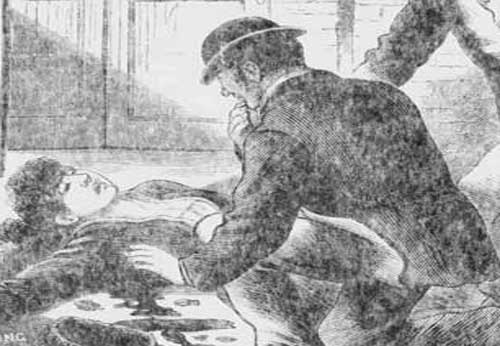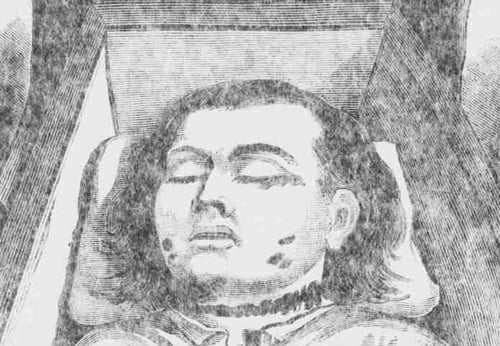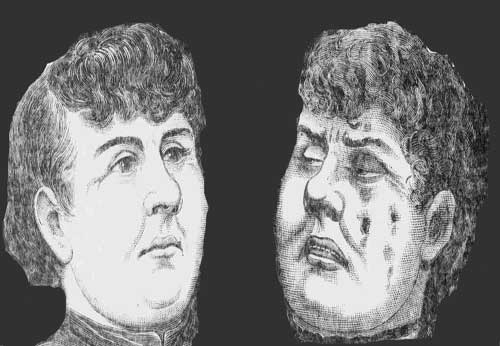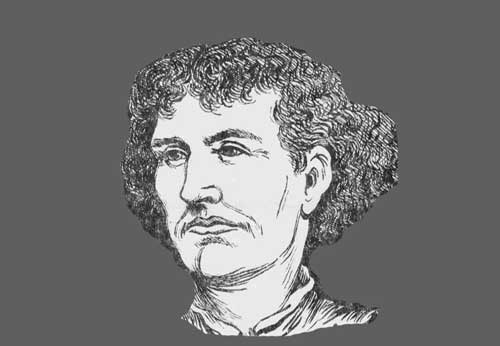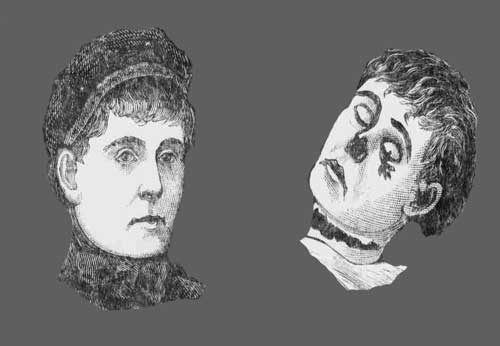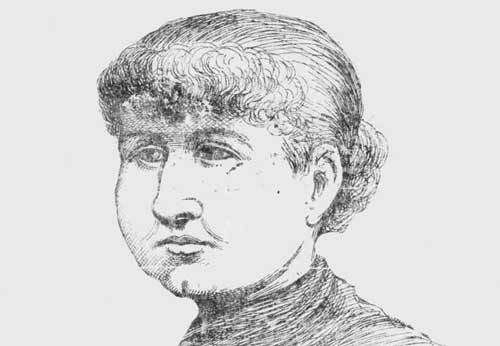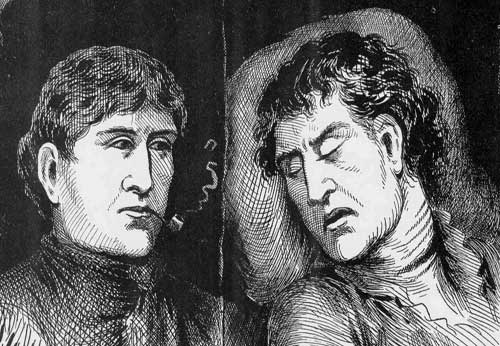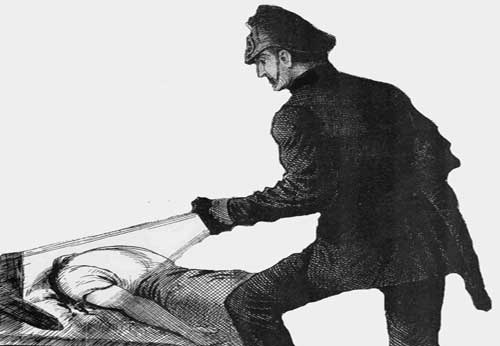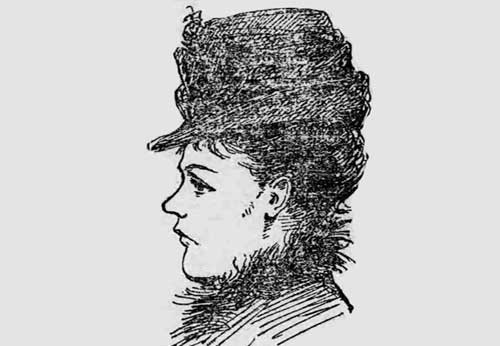- The body of Rose Mylett was found in a dark alleyway in Poplar on 20th December, 1888.
- At first it was believed that she was another victim of jack the Ripper.
- Consequently the people of East London faced Christmas with extreme unease.
- Site Author and Publisher Richard Jones
- Richard Jones
ROSE MYLETT - MURDERED 20TH DECEMBER, 1888
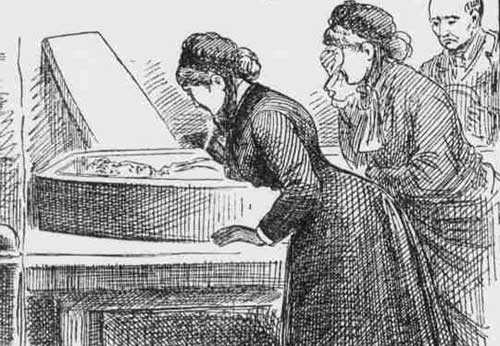
THE RETURN OF THE RIPPER
At 7.55pm, on Wednesday 19th December 1888, Charles Ptolomey was making his way along England-row, off Poplar High Street, when he saw a woman in the company of two sailors by the entrance to Clarke's Yard, on the opposite side of the High Street.
One sailor was around 5 foot eleven inches tall and, in Ptolomey's opinion, "looked like a Yankee"; and the other was about 5 foot seven inches tall.
Ptolomey later recalled that the shorter one was talking to the woman, whom he later identified as Rose Mylett when he was taken to view her body at the mortuary, whilst the taller of the two was walking up and down. "So strange did it seem", he later told the Daily Chronicle, "that I stopped and took account of them."
He then heard the woman say to the shorter sailor "No, no, no!" and heard the shorter seaman speak to her in a low tone.
"It struck me that they were there for no good purpose" he later recalled, "and that was the reason I took so much notice of their movements. I shall always remember their faces, and I could pick them out of a thousand."
He also stressed that, when he had seen her, Rose Mylett seemed perfectly sober.
At 2.30am, on the morning of the 20th December, she was seen by Alice Graves in the company of two men out side The George pub on Commercial Road, by which time she appeared quite drunk.
Her Body Is Found - Foul Play Not Suspected
At 4.30am Police Sergeant Robert Golding and Police Constable Thomas Costello found her dead in Clarke's Yard. Her body was still warm, suggesting that death had occurred only a short time before.
According to a later report by Metropolitan Police Commissioner, James Monro:-
"...The face was perfectly placid. The clothes were not disarranged and round the neck was a handkerchief loosely folded, but not tied. In the pocket of the dress was a small phial, empty. In one of the ears was an ear-ring; the other was missing.
There were absolutely no signs whatever of any struggle, and no marks of violence visible.
The police believed from the appearance of the body that the case was one of suicide or sudden death from natural causes..."
Assistant Divisional Police Surgeon, Dr. George James Harris, was sent for and, having carried out a cursory examination of the body, in the course of which he found no marks, or signs of foul play, he pronounced life extinct and ordered that the body be removed to the mortuary.
Here, the mortuary keeper, and Coroner's assistant, Curtain T. Chivers, discovered a mark around her neck, which was approximately an eighth of an inch deep, with some scratches above it.
The Postmortem Disagrees With The Police
A postmortem was subsequently ordered, and was duly carried out, on 21st December, 1888 by Divisional Police Surgeon Dr. Matthew Brownfield.
His findings, as stated in his subsequent report, and presented at the opening of the inquest into Rose Mylett' death that was held that same day, were as follows.
"Blood was oozing from the nostrils, and there was a slight abrasion on the right side of the face.
On the neck was a mark which had evidently been caused by cord drawn tightly round the neck, from the spine to the left ear. Such a mark would have been by a four-thread cord.
There were also impressions of the thumbs and middle and index fingers of some person plainly visible on each side of the neck...Death was due to strangulation. Deceased could not have done it herself. Marks on her neck were probably caused by her trying to pull the cord off.
The murderer must have stood at the left rear of the woman, and, having the ends of the cord round his hands, thrown it round her throat, crossed his hands, and thus strangled her..."
Police Embarrassment
At the inquest it transpired that the police were unaware of Brownfield's conclusion that Rose Mylett had been murdered and, therefore, since they were still of the opinion that her death had been accidental, they had not actually launched an investigation.
As Commissioner Monro put it in his report, "This evidence was certainly a matter of surprise to the police, but accepting the medical evidence as correct, the case was clearly one of murder..."
Monro confessed that he himself had been wrong-footed by the victim's "perfectly placid features" and by the "absence of all signs of violence when the body was discovered..."
He, therefore, sought a second opinion, and asked Surgeon Mr. Mackellar to make a further examination.
Mackellar concurred with Brownfield's findings that death was the result of strangulation, leaving, a somewhat nonplussed, Commissioner Monro to opine that "there is therefore no doubt that the case was one of murder - and murder of a strange and unusual type."
Had Jack the Ripper Returned?
Inevitably, the question was soon being raised as to whether or not this new atrocity spelt the return of Jack the Ripper.
The police, and the majority of the newspapers, seem to have been anxious to dispel any rumours that the murder of Rose Mylett had been the work of Jack the Ripper.
Indeed, there seems to have been a marked determination by the press to avoid the sensationalism that had caused so much panic and unrest in the wake of the previous killings.
The Coroner, Wynne Baxter, was reported as stating at the inquest that, "..The usual signs of strangulation, such as protrusion of the tongue and clenching of the hands, were absent, there being nothing all suggestive of death by violence."
He did, however, point out that such signs were often not present in cases where the violence had been very sudden.
The jury, faced with a large amount of medical testimony and evidence that pointed to strangulation returned a verdict of "Murder by person, or persons unknown."
Reporting on the verdict the Advertiser, reflecting the view held by several other newspapers that the area had had enough of the Whitechapel horrors, commented that, " It is unfortunate that there is a fundamental difference of opinion between the coroner and the jury...For months past there has been a succession of abhorrent enormities forced upon public attention, and it would have been a great relief to have been assured that the death of Rose Millett sic was due to accidental strangulation...As the matter stands additional responsibility is thrown upon the metropolitan police, who from the first have contended that the death was attributable natural causes...The truth may never be known with certainty until the adage that "murder will out" - if murder it be - is once more justified."
It is evident from this, and other reports on what was being dubbed the "Poplar Mystery" that many newspapers were desperately trying to report responsibly on the murder in order to prevent further outbreaks of panic in the district.
The Star Newspaper Stirs It Up - Again!
However, one newspaper in particular seemed determined to lay the blame for this latest, apparent, atrocity firmly at the ripper's door.
On 24th December 1888 The Star, the newspaper whose earlier reporting had done so much to stir up the Leather Apron scare, broke ranks with the majority of other papers and, in an article that bore the tantalising headline, "IS HE A THUG? A STARTLING LIGHT ON THE WHITE-CHAPEL CRIMES. THE ROPE BEFORE THE KNIFE.", it complained that, "...The town has supped so full of horrors that mere murder unaccompanied by revolting mutilation passes apparently for common-place, and the discovery on Thursday morning...of a woman's dead body with the white mark of a strangler's cord around her throat has failed to create any excitement even in the neighbourhood..."
Adopting the same chilling tone as it had with its "Leather Apron" campaign, a tone designed to terrify the local residents, the article went on to opine that, "...The swift and silent method of the Thug is a new and terrifying feature in London crime, and this murder is invested with a startling significance by the discovery that it has a possible bearing upon the series of Whitechapel Crimes. The suggestion is this:- "Was the Poplar Murder another of the series of Whitechapel and the work of the same man? If so, has the murderer changed his methods, or is it not possible that the deed of Clarke's-yard is a new revelation of his old methods - that in the other cases partial strangulation was first of all resorted to, and that when the victims were by this means rendered helpless, THE KNIFE WAS USED in such a manner as to obliterate the traces of the act?""
The article went on to suggest that the previous victims may well have been rendered unconscious by the same method as had been used on Rose Mylett - i.e. strangulation - but that the marks were not apparent because the killer had then gone on to cut their throats and thus destroy the evidence of the strangulation.
Quoting no less an authority than Dr. George Bagster Phillips the Police Surgeon who had inspected the body of Annie Chapman, as it lay in the backyard of 29 Hanbury Street, - even though Phillips had refused to talk to their reporter so they were, to quote the article, reliant on "another source" concerning Phillips's opinion - "...the Poplar Murder and the Whitechapel Murderer are one and the same man [and] the method of preliminary strangulation was certainly employed in Hanbury-street, and was possibly employed in the other cases.."
Was Rose Mylett A Victim of Jack the Ripper?
All of which leaves us with the question as to whether, as well as being a "Whitechapel Murders" victim, Rose Mylett was a victim of Jack the Ripper.
The honest answer is that we don't, and never, will know for certain.
The evidence would suggest that she wasn't and the majority of experts are in agreement that this is, indeed, the case.
Indeed, not withstanding the Star's attempts to link her death to the earlier victims of Jack the Ripper, and their reporting their obvious fabrication of Dr Phillips's opinion by citing a "source close to him", her injuries simply weren't consistent with the mutilations that were the, by then, all too familiar modus operandi of Jack the Ripper.
Perhaps the last word should go to Dr. Robert Anderson who, writing in his memoirs in 1910, stated emphatically that, ".. the Poplar case of December 1888, was death from natural causes, and but for the "Jack the Ripper" scare, no one would have thought of suggesting that it was a homicide."
Evidently, over twenty years later and, it must be said, in the face of considerable evidence to the contrary, Anderson clung rigidly to the belief that Rose Mylett was not only not a ripper victim, but he also doubted that she had even been the victim of murder!

